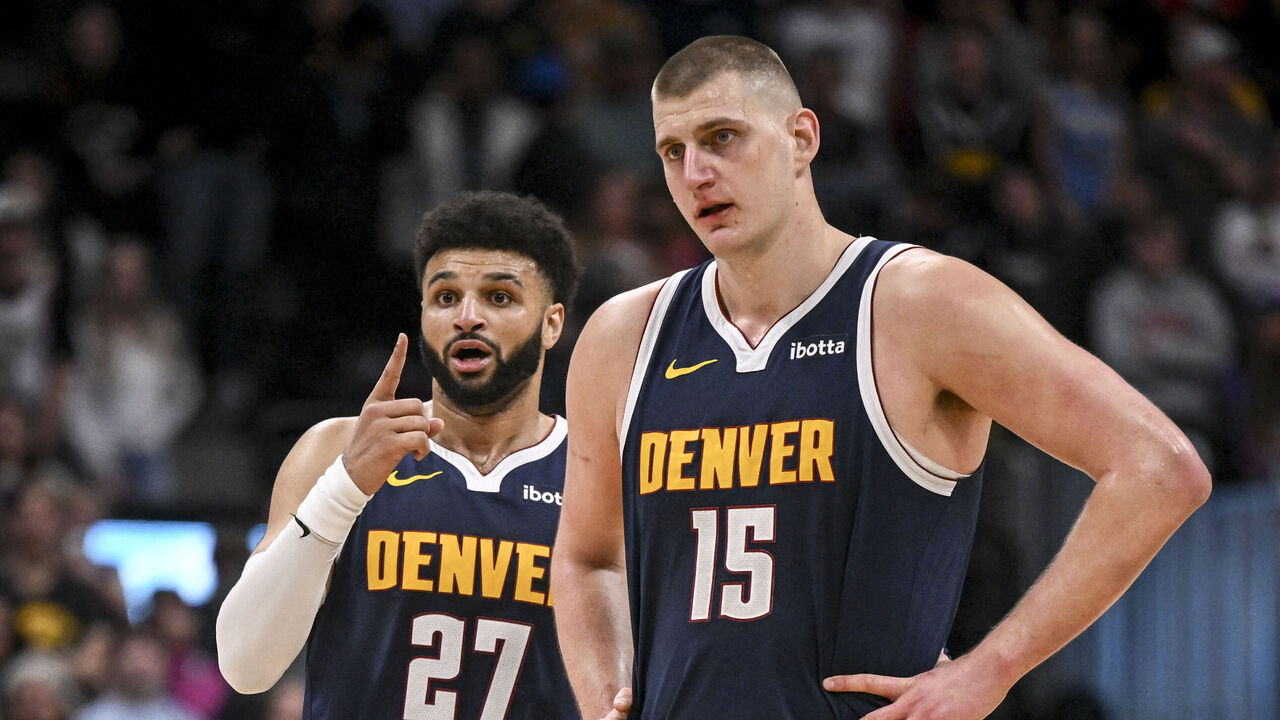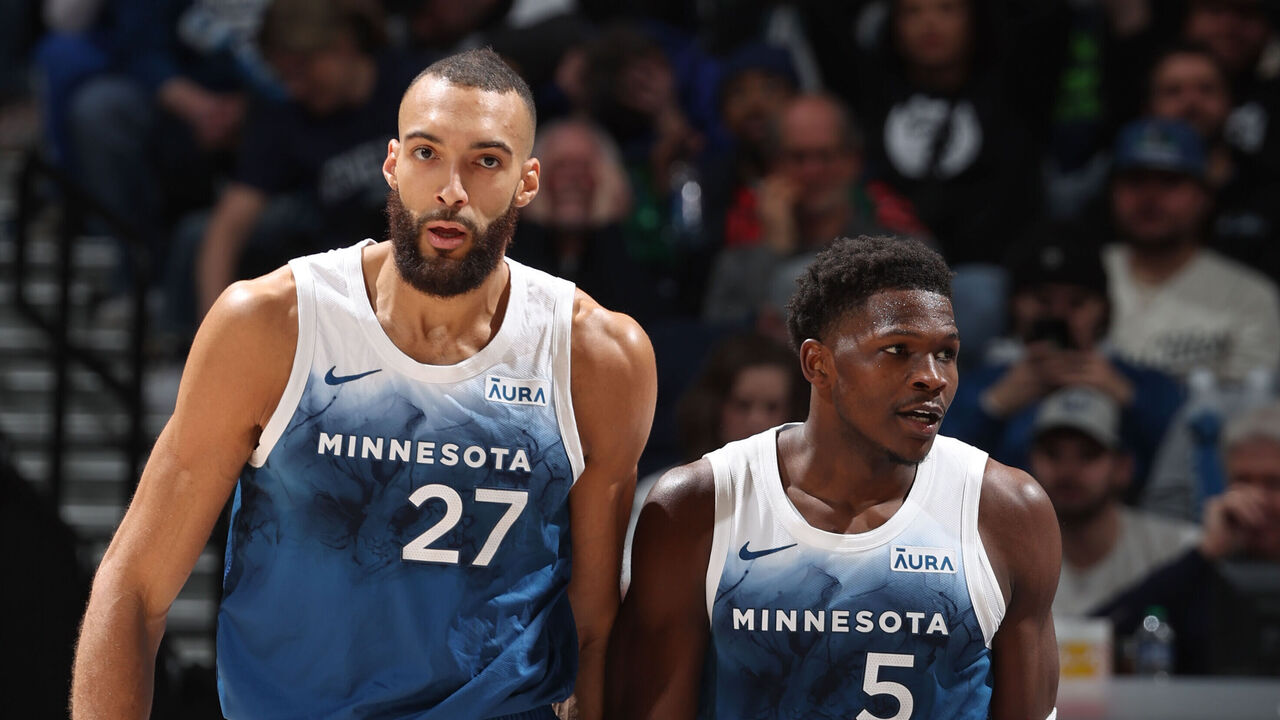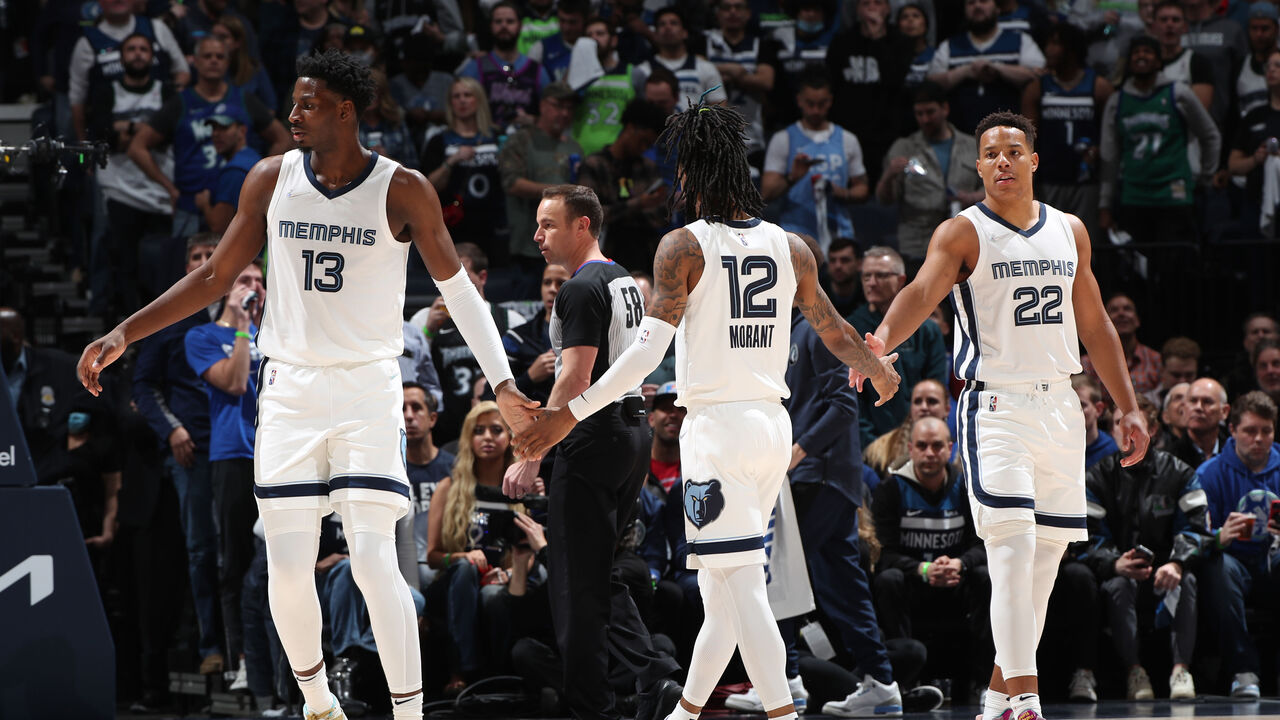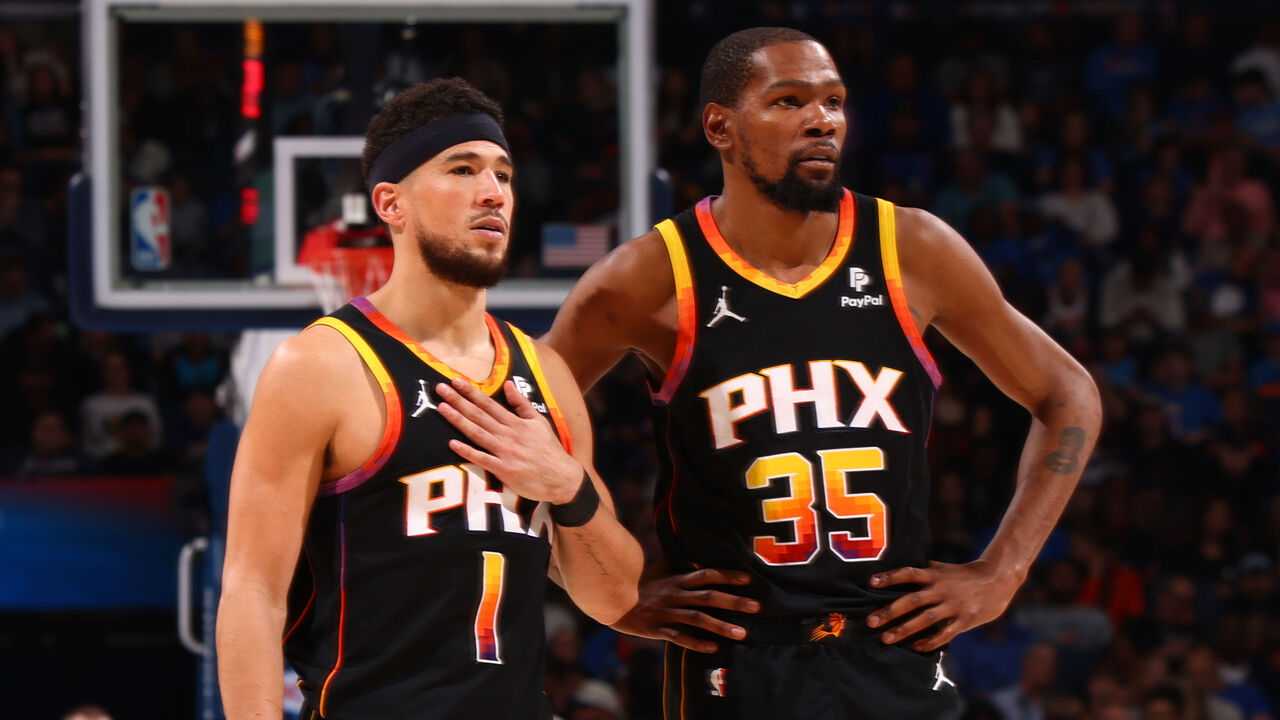Dynasties have historically ruled the NBA, but we’re in an era of nearly unprecedented parity that’s produced six different champions over the last six years. This coming season features another deep and diverse field of contenders. We’re laying out reasons to believe in them and reasons to doubt them.
Part 1 featured the Eastern and Western Conference favorites. Next up, the second tier of contenders in the West.
Dallas Mavericks

Reasons to believe: A generational talent like Luka Doncic always gives a team the inside track, and the reigning West champs finally found the right mix around Doncic last season. Now they return the same core with the additions of Klay Thompson and Naji Marshall.
Doncic and a more focused Kyrie Irving form what’s arguably the league’s most dynamic offensive duo, with Thompson’s shooting and off-ball movement set to unlock even more possibilities. Despite being a less explosive player in the latter stages of his career, the threat of Thompson’s jumper – and quick trigger – will give opponents all kinds of headaches with Doncic and Irving dominating the ball. The Mavs’ star guards and drive-and-kick attack should also help Thompson post some semblance of a bounce-back season. Meanwhile, center Dereck Lively II’s rapid improvement as a rookie bodes well for his sophomore campaign, which should be filled with more rim-running exploits and lobs from Doncic.
On the other end, the defensive boost Dallas got from midseason trades for Daniel Gafford and P.J. Washington was a key factor in its unlikely run to the Finals – but something about it still felt like smoke and mirrors. The acquisition of Marshall should quell some fears about defensive regression. The ex-Pelicans forward is a hard-nosed defender who isn’t afraid to stir the pot. As a bonus, he shot 42% from the corners last season and now joins a Doncic-led team that consistently creates the most corner threes.
Dallas has the goods to get back to the Finals, and Doncic won’t be satisfied with just making the trip.
Reasons to doubt: The same reasons Dallas’ 2024 run felt unsustainable.
It’s hard to believe Irving will remain focused on the task at hand for two consecutive seasons, or that he’ll even be available often enough – the eight-time All-Star cracked the 60-game mark just once in the last five years. And if Irving and Doncic do stay healthy, can Washington, a 34-year-old Thompson, or a 20-year-old Lively really be the third-best player on a championship team?
Then there’s the defense. While Marshall will provide a nice boost, there are still plenty of concerns about a team that will have Irving, Doncic, and Thompson sharing the court for plenty of minutes. Any defensive slippage from the second half of last season could see the Mavs once again bleeding points as rapidly as Doncic and Co. produce them on the other end.
Finally, the Western Conference is an unforgiving gauntlet. For virtually every West contender, the risk of playing great basketball and still ending up with an unfavorable seed or playoff matchup is all too real. – Joseph Casciaro
Denver Nuggets

Reasons to believe: There’s always a case for optimism when you have the best player in the world – a three-time MVP, proven championship engine, and one of the greatest offensive orchestrators we’ve ever seen – squarely in his prime. Nikola Jokic remains the most ingenious passer, the most unstoppable post scorer, and the best floater artist in the game, and the Nuggets are a nightmare to defend almost regardless of who plays next to him. They’ve posted an offensive rating above 124 in each of the last two seasons with him on the floor, and he’s on the floor a lot because he never gets injured.
Some people may have registered last year as a disappointing follow-up to Denver’s 2023 championship season because the team got bounced in the second round. Here’s an alternate view: Winning 57 games, with top-eight marks on both sides of the ball, before ousting the Lakers and going the distance against an awesome Timberwolves team – while Jamal Murray was clearly operating well south of 100% – was actually a pretty inspired title defense.
The Nuggets morphing into a borderline-elite defensive team was a massive factor in their title run, and the fact that they carried over and sustained that improvement for an entire season was one of the most important developments of the 2023-24 campaign. Aaron Gordon is a perfect complement to Jokic on that end thanks to his ability to anchor the back line when Jokic plays at the level in pick-and-roll coverage, as well as his ability to guard centers so Jokic can hide on nonthreatening wings. Michael Porter Jr. has improved immensely as a low helper, too.
And sure, Kentavious Caldwell-Pope was a major component of that defense at the point of attack, but I’m not sure Denver will be any worse off giving his minutes to bouncier youngsters like Christian Braun and Peyton Watson. Russell Westbrook is also a massive defensive upgrade over previous backup point guard Reggie Jackson, especially as a rebounder, and he can turn those rebounds into the kind of transition possessions the Nuggets (who ranked 28th in offensive pace) could use more of.
Jokic and Murray can carry the half-court offense almost by themselves; there’s still no good answer for their two-man game when Murray’s healthy. Gordon is a dunker-spot savant and duck-in enthusiast who feasts off Jokic’s interior passing. Porter’s one of the best shooters in the world. The Nuggets’ starting lineup (the most-used five-man group in the league last season) outscored opponents by 13 points per 100 possessions.
With all that in mind, it’s easy to envision the Nuggets as a 50-plus-win squad in the thick of the title chase.
Reasons to doubt: As extraordinary as Jokic is, he can only take Denver so far without quality guard play alongside him. Any time Murray’s been either absent or hobbled, this team has butted up against a second-round ceiling. And there are definite concerns about Murray’s health and productivity after his ugly finish to last postseason and his disastrous showing for Team Canada in Paris.
What’s more, the Nuggets ranked dead last in 3-point attempt rate last season, and then lost one of their best 3-point shooters in Caldwell-Pope. They made up for that long-range deficiency by getting to the rim a ton and ranking third in mid-range shooting, which helped them finish fifth in offensive efficiency during the regular season. But that offense fell off a cliff in the playoffs, when they plummeted to 10th among 16 teams. They also had the worst offense of any second-round team, scoring a paltry 106.6 points per 100 possessions against the Wolves.
Caldwell-Pope may not have hoisted threes at especially high volume, but he commanded respect on the perimeter, whether he was spotting up or coming off a pindown or dribble-handoff. Braun won’t attract the same level of attention. Julian Strawther might, but he’s limited in other areas. And Westbrook won’t help on the shooting front.
Unless Murray regains his All-NBA 2023 postseason form, this Denver offense looks flawed enough that even Jokic might not be able to save it. – Joe Wolfond
Minnesota Timberwolves

Reasons to believe: After notching 56 wins and knocking off the Nuggets en route to the franchise’s first conference finals berth in 20 years, the Timberwolves still have the ingredients necessary to compete for the team’s first championship. It’s just a different recipe without Karl-Anthony Towns.
Anthony Edwards is a genuine superstar (and he knows it): that must-watch breed of audacious athlete seemingly made for the biggest moments and brightest spotlights. Edwards took another leap as a two-way wing last season, ratcheting his playmaking and defensive consistency up a level. At his best, Edwards will almost undoubtedly be good enough to serve as a title team’s best player.
That suited Towns, who emerged as a nearly perfect No. 2 on offense. Julius Randle – an inferior shooter but a better playmaker – can pick up that mantle, especially if he stays true to his promise to play team-first basketball. The bruising forward’s process may not be as aesthetically pleasing as Towns’, but Randle’s production is undeniable – 24.7 points, 9.7 rebounds, and 4.4 assists per game over the last two seasons. In addition, last season marked the first time in nine years that the durable big man missed more than 10 games in a season.
Meanwhile, Donte DiVincenzo’s shooting (40% on 7.1 3-point attempts per game over the last two seasons) should help the Timberwolves replace some of Towns’ efficiency and volume, plus the spacing that came with it. The Big Ragu will also bolster an already stout defensive unit on the perimeter.
In Rudy Gobert’s second season in Minnesota, the Stifle Tower returned to his dominant defensive ways. Though talk of Gobert’s versatility – or rather, his lack thereof – will always linger, his paint protection remains one of the defining defensive skills of the modern era, as evidenced by the fact he collected a record-tying fourth Defensive Player of the Year award in 2023-24.
The Wolves will once again boast an elite defense, with All-Defensive team selection Jaden McDaniels still getting better. With the steady hand of Mike Conley at the point and the bench scoring of reigning Sixth Man of the Year Naz Reid to complement Edwards, Randle, and Co., Minnesota still boasts one of the league’s highest two-way ceilings.
Reasons to doubt: For all his production and bravado, Edwards might not be ready to lead a team all the way to a title. Though his postseason heroics last spring outweighed his struggles in the conference finals, the 23-year-old clearly ran out of gas against Dallas. And with Randle lining up alongside Gobert and McDaniels, Edwards will have less space to operate than ever before.
As for Randle, the three-time All-Star is a playoff pumpkin. Among the 137 active players who’ve attempted at least 240 shots in the postseason, Randle’s career playoff effective field-goal percentage of 40.2% ranks last. He’s also recorded more postseason turnovers than assists. Can a shaky-shooting, defensively inconsistent forward who requires the ball as much as Randle does impact winning at a championship level? How will the veteran react if he often finds himself riding the bench in crunch time because of Reid’s superior fit with Minnesota’s best players? These are questions to consider for the new-look Wolves.
Elsewhere in the frontcourt, Gobert’s offensive limitations and mobility can be genuine causes for concern, even if they’re overblown.
Then there’s injury regression and depth. The Timberwolves were one of the healthiest teams last season, a stroke of luck that’s tough to bank on repeating. Their top seven is solid, but beyond that, there are questions. After earning a key rotation spot last season, Nickeil Alexander-Walker lost his jumper, his confidence, and ultimately his minutes as the 2024 playoffs unfolded. He then looked like a shell of himself while representing Canada at this summer’s Olympics, where he missed all nine of his field-goal attempts. Joe Ingles, meanwhile, just turned 37 years old. If the Wolves’ injury luck simply regresses to the mean, an all-in contender might find itself leaning too heavily on rookies Rob Dillingham and Terrence Shannon Jr. – Casciaro
Memphis Grizzlies

Reasons to believe: The core of this team, when healthy, is a proven wins machine.
It’s easy to forget after a 2023-24 season that was completely lost to injuries, which itself came on the heels of a 2022-23 season that unraveled for a multitude of reasons, but the Grizzlies were the up-and-coming young team in the NBA very recently. They won 56 games and might well have knocked off the eventual champion Warriors in the second round in 2022 if not for Ja Morant’s series-ending injury. In Morant, Jaren Jackson Jr., and Desmond Bane, they have the same synergistic 26-and-under nucleus now that they had then.
The starting lineup should be rounded out by rugged veteran guard Marcus Smart (who can help insulate Morant defensively) and hulking rookie center Zach Edey (who can help insulate Jackson on the boards). Smart and Jackson give the team a high defensive floor, bracketing the starters with one former Defensive Player of the Year at the point of attack and another on the back line. At the other end, Morant and Bane represent one of the NBA’s best offensive backcourts. Edey will carve out space for them as a screener and create extra shots for them as an offensive rebounder. This team could easily be top 10 on both sides of the ball.
Beyond their promising starting group, the Grizzlies might be the deepest team in the league. With a bench consisting of pogo-stick combo big Brandon Clarke, stretch forward Santi Aldama, all-court chaos agent Vince Williams Jr., teenage gunslinger GG Jackson, savvy point guard Scottie Pippen Jr., gap-filling wing John Konchar, and deadeye sharpshooter Luke Kennard, they can build all kinds of lineups to suit all kinds of situations. They should be able to weather injuries, too, as long as those injuries don’t once again cost their projected starters a combined 273 games.
Reasons to doubt: As eager as the Grizzlies must be to put the last year-and-a-half behind them, we can’t just hand-wave away the causes of their dysfunction.
For one thing, Morant still has to demonstrate that he’s matured enough to avoid becoming an off-court distraction. For another, even if Memphis doesn’t have to trot out a record 33 players over the course of this season (as it did last year), there are a lot of injury-prone players on the roster; a clean bill of health is far from assured.
Jackson and Smart have to prove they can still defend at DPOY levels after dipping significantly on that end since earning their crowning achievements. Clarke has to prove that a surgically repaired Achilles tendon hasn’t sapped his bounce. Young role players like Williams, Pippen, and GG Jackson – who impressed for a tanking team last season – have to prove they can contribute to a winner. And Edey has to prove he’s actually ready to start as a rookie.
Even if all of those guys prove all of those things, shooting looms as a limitation for this team. Even in their recent 50-plus-win campaigns, the Grizzlies finished in the bottom half of the league in both 3-point attempt rate and 3-point percentage, and that seems unlikely to improve this year. Spacing will be a challenge anytime they have Morant, Smart, and a traditional center on the floor.
Finding the right offense/defense balance will be a tricky juggling act, no matter how many lineup combinations their depth affords them. And that depth becomes a lot less valuable in the postseason. It’s not hard to picture a healthier Grizzlies squad once again thriving in the regular season; it’s just a lot harder to imagine them making it work in the playoffs. – Wolfond
Phoenix Suns

Reasons to believe: Despite the lingering stench of last year’s playoff stink bomb, it’s worth keeping the incense alight for Devin Booker (an All-NBAer firmly in his prime) and Kevin Durant (past his peak but still a top-10 talent who played the sixth-most minutes in the league last season). Bradley Beal never quite looked comfortable after missing the first two months of his first Suns campaign, and he still put up 51/43/81 shooting splits. Grayson Allen led the league in 3-point percentage and Phoenix as a team ranked fifth. On paper, this is a much better offense than the one that ranked ninth in the NBA in 2023-24.
One of the biggest things holding them back was their complete carelessness with the basketball, resulting in the league’s fourth-highest turnover rate. Enter offseason signee Tyus Jones. One of the game’s preeminent caretaker point guards, he’s led the league in assist-to-turnover ratio for the last six years running (and posted a record 7.3-to-1 ratio last season). In four of those six years, Monte Morris finished second to Jones in that category. Guess what? Morris also signed with the Suns this summer. Both those guys can shoot the ball, too, with 37% and 39% career marks (albeit on low volume) from long range, respectively. And while Jones is undersized at 6-foot-1, he’s a strong and feisty defender who impacts the ball more than you’d expect for someone with his dimensions.
On top of having the true point guard play they lacked last season, Phoenix gets a more reliable backup center behind Jusuf Nurkic in Mason Plumlee, who can approximate Nurkic’s screening and (most importantly) connective passing ability. Last season, the Suns dropped off by 12.1 points per 100 possessions when Nurkic hit the bench and was replaced by either Drew Eubanks or Durant at the five. They’ll also get a full season with Royce O’Neale, who helped immensely as a wing defender, shooter, and connective playmaker after arriving in a deadline-day trade. Phoenix outscored opponents by 10.8 points per 100 with him on the floor. It feels like there’s more functional depth here now than there was a year ago.
Finally, Mike Budenholzer will preside over the Suns’ augmented roster in place of Frank Vogel. Budenholzer has a long track record of getting the most out of teams (at least in the regular season) via savvy macro-tactical shifts. A big one: His teams always get up a ton of threes, and the Suns (who ranked 21st in 3-point attempt rate last season) could certainly benefit from a boost in that department.
Reasons to doubt: For all of Phoenix’s tweaks on the margins, this is still a top-heavy team that relies overwhelmingly on three players. So it’s hard to feel confident after the Suns failed to win a single playoff game with all three of them healthy last spring. Especially when one of those players is 36, another appears to be declining at 31, and the trio as a whole has shown minimal signs of being mutually complementary.
You could maybe add Nurkic to that group and call it a quartet – the big Bosnian’s on-court impact has always exceeded the oft-clunky aesthetics of his game – but he’s not necessarily reliable either, given his injury history and his limitations as an interior finisher and defender in space. In short, Phoenix’s core group is more likely to get worse than it is to get better. Sure, Beal missed a bunch of time early in the year, but the Suns got Durant’s healthiest season in a decade and Nurkic’s healthiest in six years. How likely is that to recur?
The Suns overachieved by finishing 13th in defensive efficiency last season, but they clearly lacked the requisite size and physicality on that end to truly contend. Those limitations were laid particularly bare in the playoffs, when they surrendered 123.2 points per 100 possessions to a middling Timberwolves offense. Adding Jones should help organize Phoenix offensively, but starting him, Beal, and Booker together makes a small team even smaller. While Budenholzer is a great defensive coach, triaging the Suns’ underlying issues at both ends of the floor is a monumental challenge. – Wolfond






